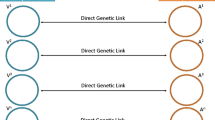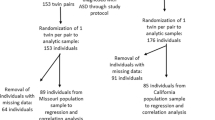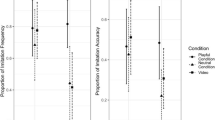Abstract
The imitative performance of 311 pairs of 24-month old twins (143 MZ, 168 same-sex DZ) was assessed via three multi-step imitative sequences. Composite imitation score correlations suggested the presence of genetic influences on imitation, with MZ correlations significantly exceeding DZ correlations. Univariate model-fitting procedures supported this finding. Substantial broad heritability was found for imitative performance, with no evidence for shared environment. However, we are unable to say with certainty to what extent this heritability is represented by additive and nonadditive genetic variance. Estimates of heritability derived from both ACE and ADE model-fitting procedures accounted for approximately 50% of the total variance, with the remaining variance in imitative performance attributable to nonshared environmental factors.

Similar content being viewed by others
References
Barr R, Dowden A, Hayne H (1996) Developmental changes in deferred imitation by 6 to 24—month old infants. Infant Behav Dev 19:159–170
Barr R, Hayne H (1999) Developmental changes in imitation from television during infancy. Child Dev 70:1067–1081
Barr R, Hayne H (2003) It’s not what you know it’s who you know: Older siblings facilitate imitation during infancy. Int J Early Years Edu 11:7–21
Bayley N (1969) Bayley scales of infant development. The Psychological Corporation, New York, NY
Carpenter M, Call J, Tomasello M (2002) Understanding “prior intentions” enables two-year olds to imitatively learn a complex task. Child Dev 73:1431–1441
Cheatham CL, Bauer PJ, Georgieff MK (2006) Predicting individual differences in recall by infants born preterm and full term. Infancy 10:17–42
DeBoer T, Wewerka S, Bauer PJ, Georgieff MK, Nelson CA (2005) Explicit memory performance in infants of diabetic mothers at 1 year of age. Dev Med Child Neurol 47:525–531
Fenstermacher SK, Saudino KJ (2006) Understanding individual differences in young children’s imitative behavior. Dev Rev 26:346–364
Field TM (1983) Discrimination and imitation of facial expressions by term and preterm neonates. Infant Behav Dev 6:485–489
Forman DR, Kochanska G (2001) Viewing imitation as child responsiveness: a link between teaching and discipline domains of socialization. Child Dev 37:198–206
Goldsmith HH, Campos JJ (1990) The structure of temperamental fear and pleasure in infants: A psychometric perspective. Child Dev 61:1944–1964
Hanna E, Meltzoff AN (1993) Peer imitation by toddlers, in laboratory, home, and day-care contexts: Implications for social learning and memory. Dev Psychol 29:701–716
Heimann M (2002) Notes on individual differences and the assumed elusiveness of neonatal imitation. In: Meltzoff AN, Prinz W (eds) Imitative mind: development, evolution, and brain bases. Cambridge University Press, New York, pp. 74–84
Heimann M, Meltzoff AN (1996) Deferred imitation in 9- and 14-month old infants: A longitudinal study of a Swedish sample. Brit J Dev Psychol 14:55–64
Kugiumutzakis G (1999) Genesis and development of early infant mimesis to facial and vocal models. In Nadel J, Butterworth G (eds), Imitation in infancy. Cambridge studies in cognitive perceptual development. Cambridge University Press, New York, pp. 36–59
Kuhl PK, Meltzoff AN (1996) Infant vocalizations in response to speech: Vocal imitation and developmental change. J Acoust Soc Am 100:2425–2438
Learmonth AE, Lamberth R, Rovee-Collier C (2005) The social context of imitation in infancy. J Exper Child Psychol 91:297–314
Liang KY, Zeger SL (1986) Longitudinal data analysis using generalized linear models. Biometrika 73:13–22
Lipps T. (1906) Leitfaeden der psychologie [The principles of psychology]. Verlag von Wilhelm Engelmann, Leipzig, Germany
Matheny AP (1975) Twins: Concordance for Piagetian-equivalent items from the Bayley Mental Test. Dev Psychol 11:224–227
McEwen F, Happe F, Bolton P, Rijsdijk F, Ronald A, Dworzynski K, Plomin R (2007) Origins of individual differences in imitation: Links with language, pretend play, and socially insightful behavior in two-year old twins. Child Dev 78: 474–492
Meltzoff AN (1995) Understanding the intentions of others: Reenactment of intended acts by 18-month old children. Dev Psychol 31:838–850
Meltzoff AN (1999) Origins of theory of mind, cognition, and communication. J Commun Disord 32:251–269
Meltzoff AN (2002) Elements of a developmental theory of imitation. In Meltzoff AN, Prinz W (eds) The imitative mind: development, evolution, and brain bases. Cambridge University Press, New York, pp. 19–41
Meltzoff AN, Moore MK (1977) Imitation of facial and manual gestures by human neonates. Science 198:75–78
Meltzoff AN, Moore MK (1997) Explaining facial imitation: A theoretical model. Early Dev Parenting, 6:179–192
Neale MC (1997) Mx: Statistical modeling. 3rd edition. Virginia Commonwealth University, Richmond, VA
Piaget J (1962) Play, dreams, and imitation in childhood. W.W. Norton and Company, New York
Saudino KJ, Carter AS, Purper-Ouakil D, Gorwood P (2007) The etiology of behavioral problems and competencies in very young twins. Manuscript submitted for publication
Williams LJ, Holahan PJ (1994) Parsimony based fit indicies for multiple fit indicator models: do they work? Struct Equation Model 1:161–198
Zeger SL, Liang KY (1986) Longitudinal data analysis for discrete and continuous outcomes. Biometrics 42:121–130
Acknowledgment
This research was supported by grants MH062375 and F31 MH07662 from the National Institutes of Mental Health.
Author information
Authors and Affiliations
Corresponding author
Additional information
Edited by Dorret Boomsma & John K Hewitt
Rights and permissions
About this article
Cite this article
Fenstermacher, S.K., Saudino, K.J. Toddler see, toddler do? Genetic and environmental influences on laboratory-assessed elicited imitation. Behav Genet 37, 639–647 (2007). https://doi.org/10.1007/s10519-007-9160-5
Received:
Accepted:
Published:
Issue Date:
DOI: https://doi.org/10.1007/s10519-007-9160-5




